Abstract
OBJECTIVES: This study detected secular change in disability and health among persons aged 55 to 70 years, the life period when increases in disability and morbidity begin and retirement occurs. METHODS: Cross-sectional comparisons were completed with data from similarly aged members of the original (n = 1760) and offspring (n = 1688) cohorts of the Framingham Heart Study, which represent 2 generations. Analyses were conducted by gender and on chronic disease subgroups by logistic regression. RESULTS: There was substantially less disability in the offspring cohort than in the original cohort. Thirty-six percent of offspring men were disabled vs 52% of original cohort men (P = .001); among women, these proportions were 54% vs 72% (P = .001). Fewer offspring perceived their health as fair or poor and fewer had chronic diseases. Offspring were more physically active and less likely to smoke or consume high amounts of alcohol, but their average weight was greater. The secular decline in disability was strongly evident among individuals with chronic diseases. CONCLUSIONS: Our findings depict a secular change toward a less disabled and globally healthier population in the period of life when retirement occurs.
Full text
PDF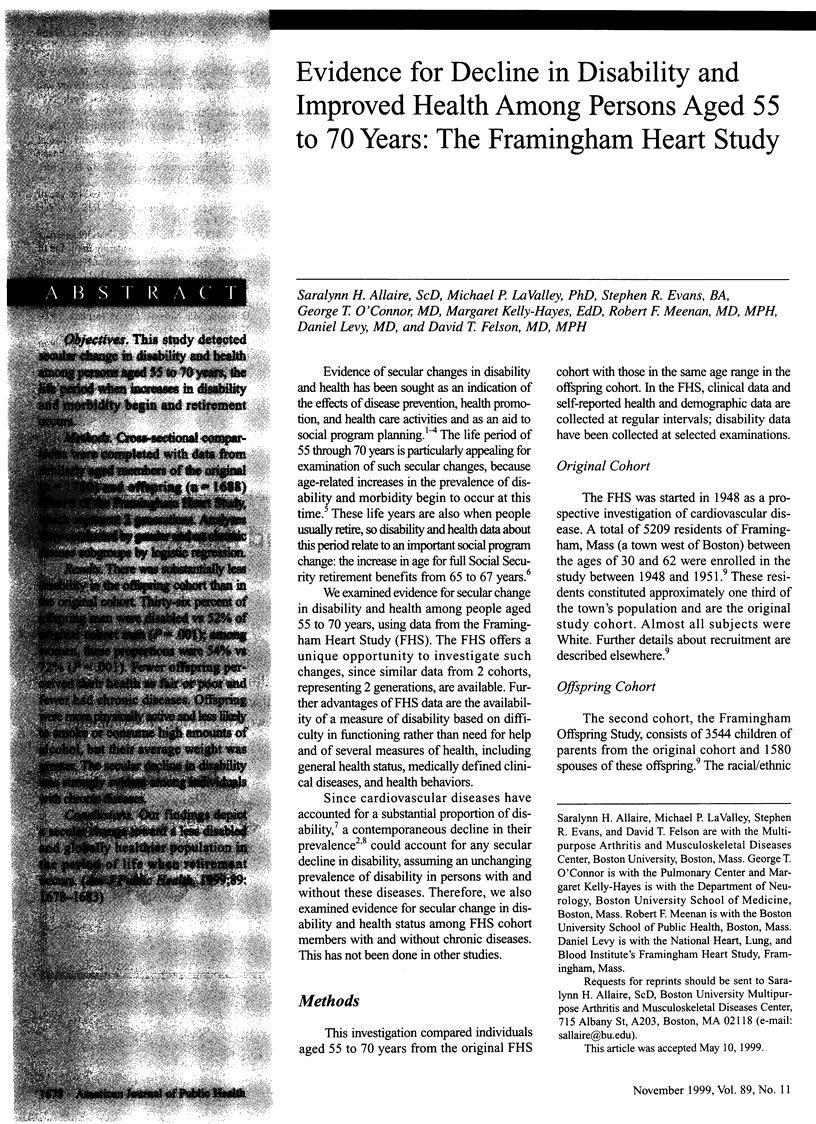

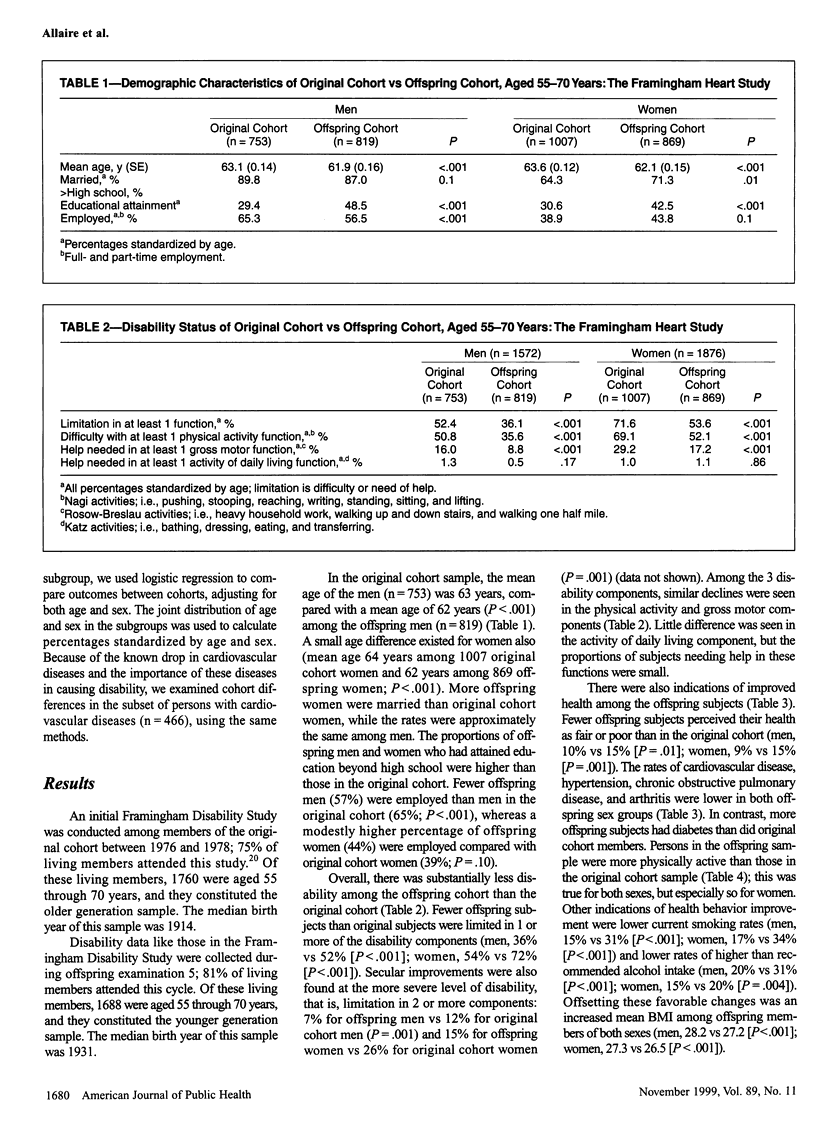
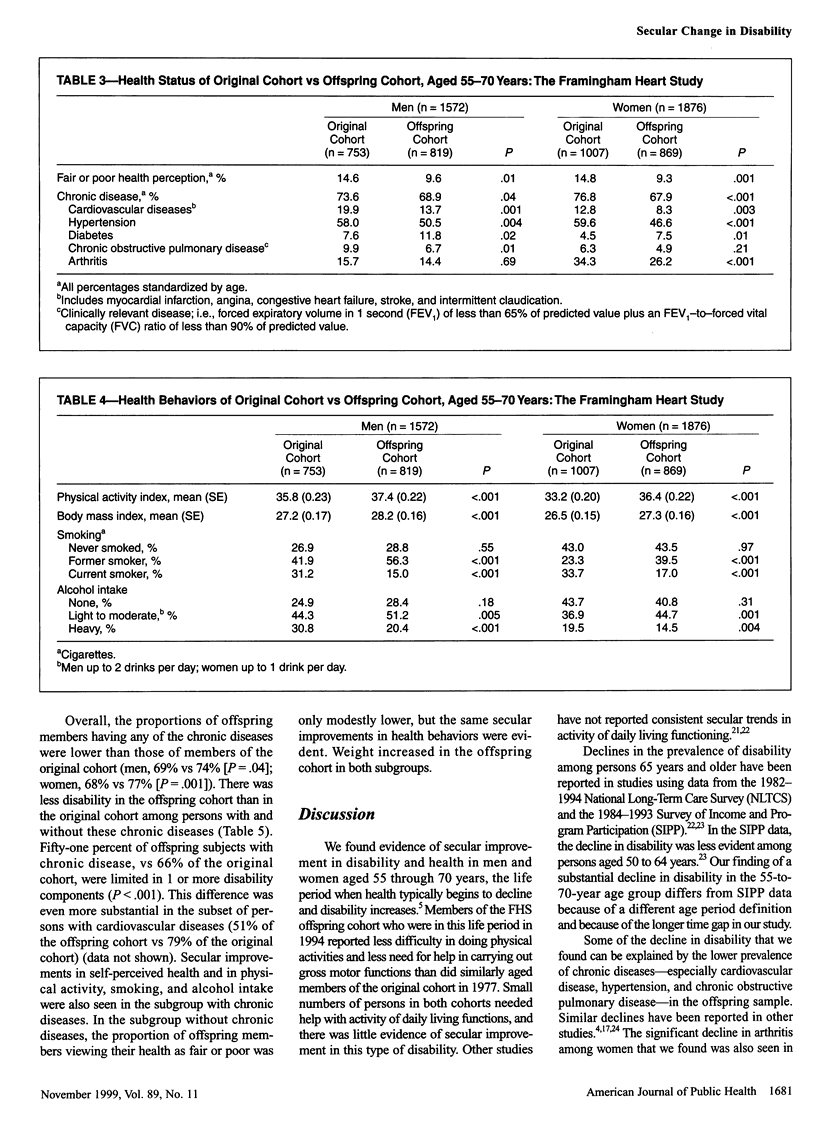
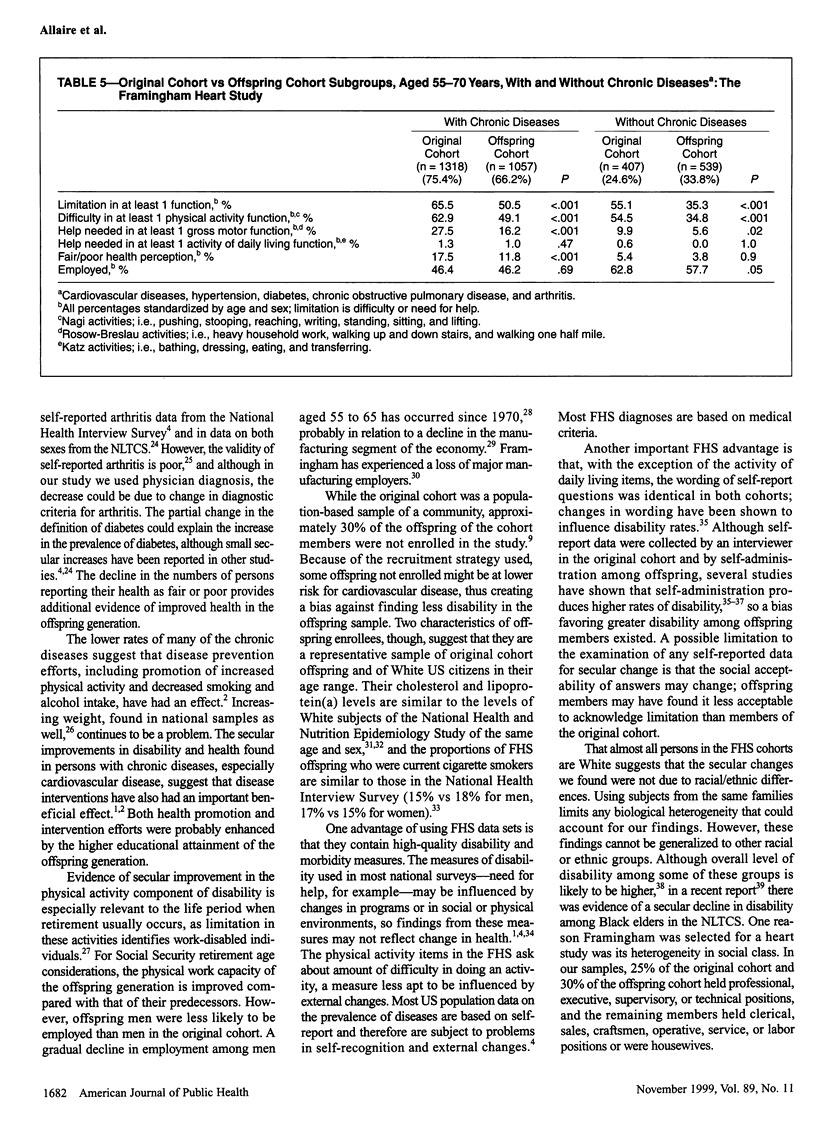
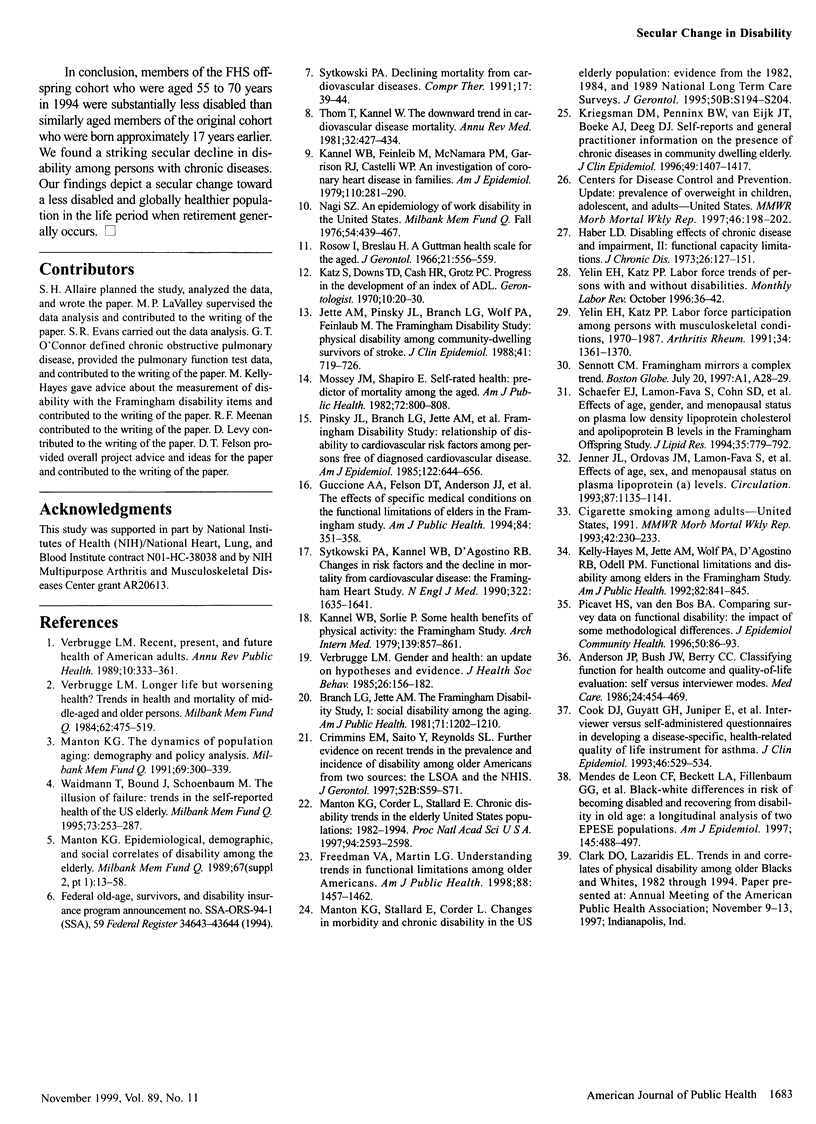
Selected References
These references are in PubMed. This may not be the complete list of references from this article.
- Anderson J. P., Bush J. W., Berry C. C. Classifying function for health outcome and quality-of-life evaluation. Self- versus interviewer modes. Med Care. 1986 May;24(5):454–469. doi: 10.1097/00005650-198605000-00008. [DOI] [PubMed] [Google Scholar]
- Branch L. G., Jette A. M. The Framingham Disability Study: I. Social disability among the aging. Am J Public Health. 1981 Nov;71(11):1202–1210. doi: 10.2105/ajph.71.11.1202. [DOI] [PMC free article] [PubMed] [Google Scholar]
- Cook D. J., Guyatt G. H., Juniper E., Griffith L., McIlroy W., Willan A., Jaeschke R., Epstein R. Interviewer versus self-administered questionnaires in developing a disease-specific, health-related quality of life instrument for asthma. J Clin Epidemiol. 1993 Jun;46(6):529–534. doi: 10.1016/0895-4356(93)90125-k. [DOI] [PubMed] [Google Scholar]
- Crimmins E. M., Saito Y., Reynolds S. L. Further evidence on recent trends in the prevalence and incidence of disability among older Americans from two sources: the LSOA and the NHIS. J Gerontol B Psychol Sci Soc Sci. 1997 Mar;52(2):S59–S71. doi: 10.1093/geronb/52b.2.s59. [DOI] [PubMed] [Google Scholar]
- Freedman V. A., Martin L. G. Understanding trends in functional limitations among older Americans. Am J Public Health. 1998 Oct;88(10):1457–1462. doi: 10.2105/ajph.88.10.1457. [DOI] [PMC free article] [PubMed] [Google Scholar]
- Guccione A. A., Felson D. T., Anderson J. J., Anthony J. M., Zhang Y., Wilson P. W., Kelly-Hayes M., Wolf P. A., Kreger B. E., Kannel W. B. The effects of specific medical conditions on the functional limitations of elders in the Framingham Study. Am J Public Health. 1994 Mar;84(3):351–358. doi: 10.2105/ajph.84.3.351. [DOI] [PMC free article] [PubMed] [Google Scholar]
- Haber L. D. Disabling effects of chronic disease and impairment. II. Functional capacity limitations. J Chronic Dis. 1973 Mar;26(3):127–151. doi: 10.1016/0021-9681(73)90086-6. [DOI] [PubMed] [Google Scholar]
- Jenner J. L., Ordovas J. M., Lamon-Fava S., Schaefer M. M., Wilson P. W., Castelli W. P., Schaefer E. J. Effects of age, sex, and menopausal status on plasma lipoprotein(a) levels. The Framingham Offspring Study. Circulation. 1993 Apr;87(4):1135–1141. doi: 10.1161/01.cir.87.4.1135. [DOI] [PubMed] [Google Scholar]
- Jette A. M., Pinsky J. L., Branch L. G., Wolf P. A., Feinleib M. The Framingham Disability Study: physical disability among community-dwelling survivors of stroke. J Clin Epidemiol. 1988;41(8):719–726. doi: 10.1016/0895-4356(88)90157-6. [DOI] [PubMed] [Google Scholar]
- Kannel W. B., Feinleib M., McNamara P. M., Garrison R. J., Castelli W. P. An investigation of coronary heart disease in families. The Framingham offspring study. Am J Epidemiol. 1979 Sep;110(3):281–290. doi: 10.1093/oxfordjournals.aje.a112813. [DOI] [PubMed] [Google Scholar]
- Kannel W. B., Sorlie P. Some health benefits of physical activity. The Framingham Study. Arch Intern Med. 1979 Aug;139(8):857–861. [PubMed] [Google Scholar]
- Katz S., Downs T. D., Cash H. R., Grotz R. C. Progress in development of the index of ADL. Gerontologist. 1970 Spring;10(1):20–30. doi: 10.1093/geront/10.1_part_1.20. [DOI] [PubMed] [Google Scholar]
- Kelly-Hayes M., Jette A. M., Wolf P. A., D'Agostino R. B., Odell P. M. Functional limitations and disability among elders in the Framingham Study. Am J Public Health. 1992 Jun;82(6):841–845. doi: 10.2105/ajph.82.6.841. [DOI] [PMC free article] [PubMed] [Google Scholar]
- Kriegsman D. M., Penninx B. W., van Eijk J. T., Boeke A. J., Deeg D. J. Self-reports and general practitioner information on the presence of chronic diseases in community dwelling elderly. A study on the accuracy of patients' self-reports and on determinants of inaccuracy. J Clin Epidemiol. 1996 Dec;49(12):1407–1417. doi: 10.1016/s0895-4356(96)00274-0. [DOI] [PubMed] [Google Scholar]
- Manton K. G., Corder L., Stallard E. Chronic disability trends in elderly United States populations: 1982-1994. Proc Natl Acad Sci U S A. 1997 Mar 18;94(6):2593–2598. doi: 10.1073/pnas.94.6.2593. [DOI] [PMC free article] [PubMed] [Google Scholar]
- Manton K. G. Epidemiological, demographic, and social correlates of disability among the elderly. Milbank Q. 1989;67 (Suppl 2 Pt 1):13–58. [PubMed] [Google Scholar]
- Mendes de Leon C. F., Beckett L. A., Fillenbaum G. G., Brock D. B., Branch L. G., Evans D. A., Berkman L. F. Black-white differences in risk of becoming disabled and recovering from disability in old age: a longitudinal analysis of two EPESE populations. Am J Epidemiol. 1997 Mar 15;145(6):488–497. doi: 10.1093/oxfordjournals.aje.a009136. [DOI] [PubMed] [Google Scholar]
- Mossey J. M., Shapiro E. Self-rated health: a predictor of mortality among the elderly. Am J Public Health. 1982 Aug;72(8):800–808. doi: 10.2105/ajph.72.8.800. [DOI] [PMC free article] [PubMed] [Google Scholar]
- Nagi S. Z. An epidemiology of disability among adults in the United States. Milbank Mem Fund Q Health Soc. 1976 Fall;54(4):439–467. [PubMed] [Google Scholar]
- Picavet H. S., van den Bos G. A. Comparing survey data on functional disability: the impact of some methodological differences. J Epidemiol Community Health. 1996 Feb;50(1):86–93. doi: 10.1136/jech.50.1.86. [DOI] [PMC free article] [PubMed] [Google Scholar]
- Pinsky J. L., Branch L. G., Jette A. M., Haynes S. G., Feinleib M., Cornoni-Huntley J. C., Bailey K. R. Framingham Disability Study: relationship of disability to cardiovascular risk factors among persons free of diagnosed cardiovascular disease. Am J Epidemiol. 1985 Oct;122(4):644–656. doi: 10.1093/oxfordjournals.aje.a114144. [DOI] [PubMed] [Google Scholar]
- Rosow I., Breslau N. A Guttman health scale for the aged. J Gerontol. 1966 Oct;21(4):556–559. doi: 10.1093/geronj/21.4.556. [DOI] [PubMed] [Google Scholar]
- Schaefer E. J., Lamon-Fava S., Cohn S. D., Schaefer M. M., Ordovas J. M., Castelli W. P., Wilson P. W. Effects of age, gender, and menopausal status on plasma low density lipoprotein cholesterol and apolipoprotein B levels in the Framingham Offspring Study. J Lipid Res. 1994 May;35(5):779–792. [PubMed] [Google Scholar]
- Sytkowski P. A. Declining mortality from cardiovascular disease. Compr Ther. 1991 May;17(5):39–44. [PubMed] [Google Scholar]
- Sytkowski P. A., Kannel W. B., D'Agostino R. B. Changes in risk factors and the decline in mortality from cardiovascular disease. The Framingham Heart Study. N Engl J Med. 1990 Jun 7;322(23):1635–1641. doi: 10.1056/NEJM199006073222304. [DOI] [PubMed] [Google Scholar]
- Thom T. J., Kannel W. B. Downward trend in cardiovascular mortality. Annu Rev Med. 1981;32:427–434. doi: 10.1146/annurev.me.32.020181.002235. [DOI] [PubMed] [Google Scholar]
- Verbrugge L. M. Gender and health: an update on hypotheses and evidence. J Health Soc Behav. 1985 Sep;26(3):156–182. [PubMed] [Google Scholar]
- Verbrugge L. M. Longer life but worsening health? Trends in health and mortality of middle-aged and older persons. Milbank Mem Fund Q Health Soc. 1984 Summer;62(3):475–519. [PubMed] [Google Scholar]
- Verbrugge L. M. Recent, present, and future health of American adults. Annu Rev Public Health. 1989;10:333–361. doi: 10.1146/annurev.pu.10.050189.002001. [DOI] [PubMed] [Google Scholar]
- Waidmann T., Bound J., Schoenbaum M. The illusion of failure: trends in the self-reported health of the U.S. elderly. Milbank Q. 1995;73(2):253–287. [PubMed] [Google Scholar]
- Yelin E. H., Katz P. P. Labor force participation among persons with musculoskeletal conditions, 1970-1987. National estimates derived from a series of cross-sections. Arthritis Rheum. 1991 Nov;34(11):1361–1370. doi: 10.1002/art.1780341104. [DOI] [PubMed] [Google Scholar]


